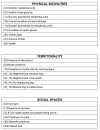Assessing urban and rural neighborhood characteristics using audit and GIS data: derivation and reliability of constructs
- PMID: 19619325
- PMCID: PMC2726116
- DOI: 10.1186/1479-5868-6-44
Assessing urban and rural neighborhood characteristics using audit and GIS data: derivation and reliability of constructs
Abstract
Background: Measures to assess neighborhood environments are needed to better understand the salient features that may enhance outdoor physical activities, such as walking and bicycling for transport or leisure. The purpose of this study was to derive constructs to describe neighborhoods using both primary (neighborhood audit) and secondary (geographic information systems) data.
Methods: We collected detailed information on 10,770 road segments using an audit and secondary data. The road segment sample was randomly split into an exploratory (60%) and validation sample (40%) for cross-validation. Using the exploratory sample (n = 6,388), seven a priori constructs were assessed separately (functionality, safety, aesthetics, destinations, incivilities, territorality, social spaces) by urbanicity using multi-group confirmatory factor analysis (CFA). Additionally, new a posteriori constructs were derived using exploratory factor analysis (EFA). For cross-validation (n = 4,382), we tested factor loadings, thresholds, correlated errors, and correlations among a posteriori constructs between the two subsamples. Two-week test-retest reliability of the final constructs using a subsample of road segments (n = 464) was examined using Spearman correlation coefficients.
Results: CFA indicated the a priori constructs did not hold in this geographic area, with the exception of physical incivilities. Therefore, we used EFA to derive a four-factor solution on the exploratory sample: arterial or thoroughfare, walkable neighborhood, physical incivilities, and decoration. Using CFA on the validation sample, the internal validity for these a posteriori constructs was high (range 0.43 to 0.73) and the fit was acceptable. Spearman correlations indicated the arterial or thoroughfare factor displayed near perfect reliability in both urban and rural segments (r = 0.96). Both the physical incivilities factor and the walkable neighborhood factor had substantial to near perfect reliability in both urban and rural segments (r = 0.77 to 0.78 and r = 0.79 to 0.82, respectively). The decoration factor displayed moderate reliability in urban segments (r = 0.50; 95% CI: 0.38-0.60) and lower reliability in rural segments (r = 0.39; 95% CI: 0.25-0.52).
Conclusion: The results of our analyses yielded four reliably and objectively measured constructs that will be used to explore associations with physical activity in urban and rural North Carolina. These constructs should be explored in other geographic areas to confirm their usefulness elsewhere.
Figures


Similar articles
-
Reliability and One-Year Stability of the PIN3 Neighborhood Environmental Audit in Urban and Rural Neighborhoods.J Urban Health. 2018 Jun;95(3):431-439. doi: 10.1007/s11524-018-0243-9. J Urban Health. 2018. PMID: 29616448 Free PMC article.
-
The Association between Neighborhood Environments and Physical Activity from Pregnancy to Postpartum: a Prospective Cohort Study.J Urban Health. 2019 Oct;96(5):703-719. doi: 10.1007/s11524-019-00376-y. J Urban Health. 2019. PMID: 31342403 Free PMC article.
-
Neighborhood walkability: field validation of geographic information system measures.Am J Prev Med. 2013 Jun;44(6):e51-5. doi: 10.1016/j.amepre.2013.01.033. Am J Prev Med. 2013. PMID: 23683990
-
Construct validity of the physical activity neighborhood environment scale-Oman.Front Public Health. 2023 Mar 17;11:1007075. doi: 10.3389/fpubh.2023.1007075. eCollection 2023. Front Public Health. 2023. PMID: 37006567 Free PMC article.
-
Direct observation of neighborhood attributes in an urban area of the US south: characterizing the social context of pregnancy.Int J Health Geogr. 2006 Mar 17;5:11. doi: 10.1186/1476-072X-5-11. Int J Health Geogr. 2006. PMID: 16545132 Free PMC article.
Cited by
-
The Healthy Community Neighborhood Initiative: Rationale and Design.Ethn Dis. 2016 Jan 21;26(1):123-32. doi: 10.18865/ed.26.1.123. Ethn Dis. 2016. PMID: 26843805 Free PMC article.
-
Reliability and One-Year Stability of the PIN3 Neighborhood Environmental Audit in Urban and Rural Neighborhoods.J Urban Health. 2018 Jun;95(3):431-439. doi: 10.1007/s11524-018-0243-9. J Urban Health. 2018. PMID: 29616448 Free PMC article.
-
The Association between Neighborhood Environments and Physical Activity from Pregnancy to Postpartum: a Prospective Cohort Study.J Urban Health. 2019 Oct;96(5):703-719. doi: 10.1007/s11524-019-00376-y. J Urban Health. 2019. PMID: 31342403 Free PMC article.
-
Assessment of neighborhood street characteristics related to physical activity in the Lower Mississippi Delta.Health Promot Perspect. 2019 Jan 23;9(1):24-30. doi: 10.15171/hpp.2019.03. eCollection 2019. Health Promot Perspect. 2019. PMID: 30788264 Free PMC article.
-
Objective assessment of urban built environment related to physical activity--development, reliability and validity of the China Urban Built Environment Scan Tool (CUBEST).BMC Public Health. 2014 Feb 4;14:109. doi: 10.1186/1471-2458-14-109. BMC Public Health. 2014. PMID: 24495676 Free PMC article.
References
-
- Brownson RC, Kelly CM, Eyler AA, Carnoske C, Grost L, Handy SL, Maddock JE, Pluto D, Ritacco BA, Sallis JF, et al. Environmental and policy approaches for promoting physical activity in the United States: a research agenda. J Physical Activity Health. 2008;5:488–503. - PubMed
-
- McLeroy K, Bibeau D, Steckler A, Glanz K. An ecological perspective on health promotion programs. Health Educa Q. 1988;15:351–377. - PubMed
-
- Sallis J, Owen N. Ecological models. In: Glanz K, Lewis FM, Rimer BK, editor. Health Behavior and Health Education: Theory, Research, and Practice. 2. San Francisco, CA: Jossey-Bass; 1997. pp. 403–424.

